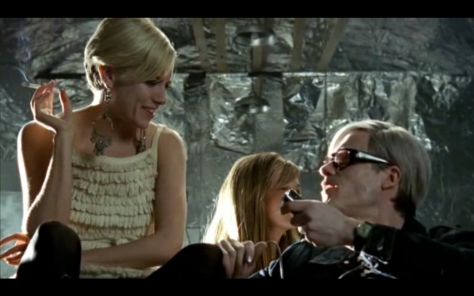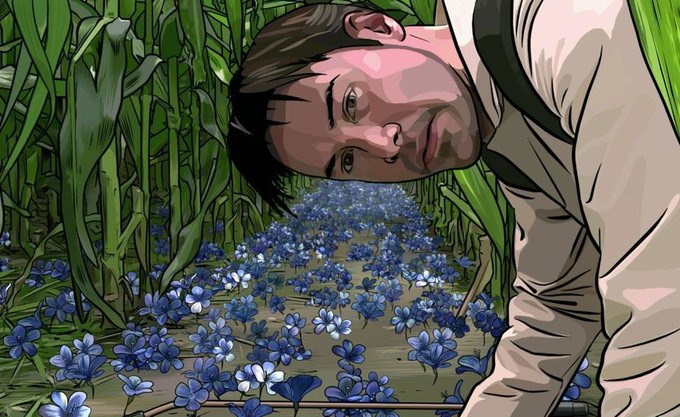By Dennis Hartley
(Originally posted on Digby’s Hullabaloo on September 22, 2007)

When I first heard that there was a new movie musical based on interpretations of classic Beatle songs, that nervous tic in my left eye started up again. I don’t think I have ever quite fully recovered from the trauma of watching Sgt. Pepper’s Lonely Hearts Club Band, the final straw that broke the back of entertainment mogul Robert Stigwood’s empire back in 1978. Sometimes, during those long dark nights of my soul, the apparition of George Burns still appears unbidden before me; singing “Fixing a Hole” (shudder!). (And let’s pretend that All This and World War II never even happened, OK?).
However, when I found out that the gifted film and stage director Julie Taymor (Titus) was at the helm, I decided to give her new piece a chance. Across the Universe is fundamentally a collection of visually stunning, slickly choreographed production numbers, all propelled by Beatles covers loosely connecting the requisite “boy meets girl” motif. Toss in 60s references (Vietnam, Leary, Kesey, Owsley, the Weathermen, Hendrix, Joplin, etc.)…and voila! The narrative is a bit thin; this will likely be a sticking point for anyone looking for a deeper meditation on the peace love and dope generation.
The story’s central character is Jude (Jim Sturgess), a young working class Liverpudlian who stows away illegally to the States in search of his father, an American GI who had a brief wartime fling with his mother. He ends up at Princeton University, where he finds out his father now works as a janitor. Jude soon falls in with Max (Joe Anderson), a free-spirited Ivy League slacker, through whom he meets the love of his life, Max’s sister Lucy (Evan Rachel Wood).
Eventually, the trio decides to drop out and move to Manhattan, where they find an apartment managed by the (sexy!) Sadie (Dana Fuchs), a hippie earth mother archetype who also is an up and coming rock singer (replete with bluesy Janis Joplin wail). The three roommates are soon sucked into the vortex of 60’s turbulence. Max is drafted and shipped to Vietnam; Lucy throws herself into political activism and the mercurial Jude, still trying to find himself, flirts with becoming an artist.
There are other main characters, but they are somewhat underwritten and largely there for color. For example, one character named Prudence (I assume you’ve caught on to the name game by now?) appears to exist solely to make her grand entrance in the film’s lamest visual pun-she comes in through the bathroom window .
There are some memorable cameos. Joe Cocker belts out a great version of “Come Together”, U-2’s Bono dispenses hallucinogens and hams it up as the day tripping “Dr. Robert”, crooning “I Am The Walrus” and Eddie Izzard (bearing an eerie resemblance to the late Oliver Reed as he appeared in Ken Russell’s Tommy) cavorts with a chorus line comprised of Blue Meanies, to the strains of “For the Benefit of Mr. Kite”.
Inevitably, a few of the more exuberant numbers recall Milos Forman’s 1979 film version of Hair. In fact, one could say that some elements of the story line in Across the Universe recall Hair as well; but I think Taymor is sharp enough to navigate that fine line between “inspiration” and “plagiarism” (or as film makers are fond of calling it: “paying homage”). I also gleaned clever references to The Graduate and Alice’s Restaurant.
If the film has a weakness, it lies in the casting of the two leads. The character of Jude, as written, has obvious parallels John Lennon’s life; Liverpool roots, an estranged father, his creative angst and inherent cynicism. Sturgess doesn’t quite have the depth that a more seasoned actor might have put into those elements of the character. Wood sleepwalks through her role; it’s a disappointing follow-up to her acclaimed performance in Thirteen.
At the end of the day, however, we must keep in mind that this is, after all, a musical. Audiences seem to be much more forgiving about rote line readings when there’s lots of good singing and dancing. Even a genuine genre classic like West Side Story had weaknesses on that front; Richard Beymer was no Brando, and Natalie Wood could have used a better dialect coach. But what do people remember most about that film? The kickass choreography and the incredible music score. And do you want to know what the best part is about Across the Universe is? The Bee Gees are nowhere in sight.


